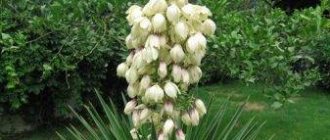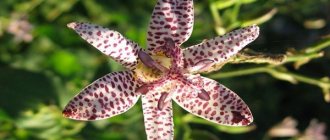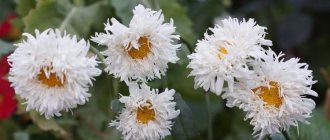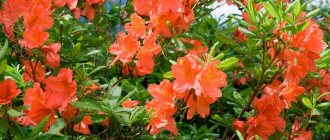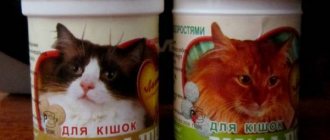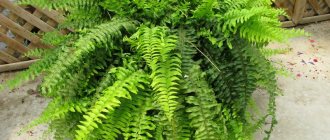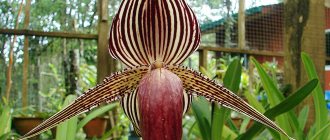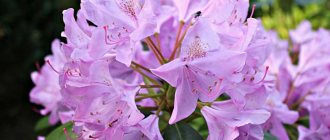Most types of mints (there are about 40 species and hybrids in total) are perennials with branched stems and simple aromatic leaves that can be pubescent. Various types and varieties of mint bloom from June to September with small, whitish or purple flowers collected in whorls or spike-shaped inflorescences.
- Origin of the name of the genus: Mint - Minta
- Cultivated species and varieties of mint for growing in gardens and pharmaceutical gardens Peppermint, cold mint or English mint, Mentha piperita
- Longleaf mint, Mentha longifolia
- Spearmint, Mentha spicata
- Round-leaved mint, or sweet mint, Mentha suaveolens
- Water mint, Mentha aquatica
Peppermint variety Grapefruit
Origin of the name of the genus: Mint - Minta
The name of the genus Mint originates from the name of the nymph of the Cokytos River Minta (or Mintha, also Menta). The Minti Mountains in Triphylia in southern Elis are also named after her. Legend has it that Minta was the concubine of Hades, who abandoned her and made Persephone, daughter of Demeter, the goddess of fertility, his wife. But Minta did not want to give up, scolded and complained about her rival, for which she was trampled by Demeter, who loved her daughter very much. At the site of the death of the nymph, mint grew. By the way, the Greeks used mint in funeral rites.
Agrotechnical requirements
Planting and caring for peppermint in the open ground is not difficult for gardeners, since the crop is winter-hardy (it tolerates frosts down to -10°C without insulation) and is unpretentious. The rhizome quickly spreads around the bush, which must be taken into account when located next to other plants. It is important to choose the right predecessors so that the yield is not reduced by pathogens or pests accumulated in the soil, as well as harmful substances released into the ground by other crops.
Peppermint can be planted after:
- cucumbers, zucchini, pumpkin;
- onions and garlic;
- green manure, legumes;
- early and cauliflower;
- tomatoes, peppers;
- potatoes, beets;
- herbs, spices.
It is undesirable to use beds after carrots, turnips, and late-ripening cabbage. Good neighbors are nettles, tomatoes, beets. Optimal conditions for growing peppermint: temperature +18-22°C (at +23-25°C the concentration of essential oil in the raw material increases, but the amount of menthol decreases), sufficient and timely soil moisture.
The crop tolerates drought, but stops growing and yield decreases.
Soil requirements
Peppermint prefers loose, well-drained, nutrient-rich soil. You can easily grow the crop on loam or sandy loam soil. The plant will die in heavy, clayey soil and in a wetland; even careful care will not help. The acidity should be pH 6-7. Adding a large amount of lime during preparation will lead to a decrease in the concentration of essential oils and a less pronounced odor. Among fertilizers, mint prefers humus, nitrogen and phosphorus mineral complexes. The spice is a perennial, and therefore requires careful pre-planting preparation of the bed.
Climatic conditions
The culture grows everywhere, adapting to the weather in any region. In the southern regions it grows well in partial shade, since it only needs 4 hours of daylight. In the north, it is better to place them in areas exposed to the sun; before winter, mulch the soil with a thick layer of humus, straw, and branches of coniferous trees. Peppermint tolerates unfavorable environmental conditions well if the place for growing is chosen correctly and the soil is sufficiently prepared.
Cultivated species and varieties of mint for growing in gardens and pharmaceutical gardens
Most mint species grow primarily in the temperate zone of the Northern Hemisphere and the Mediterranean. Mint is used for planting in flower beds and vegetable gardens; it is especially popular in Mediterranean-style aromatic gardens. There are southern varieties of mints with very beautiful leaves, but unfortunately they are not very stable in the middle zone and the Moscow region. In our flower beds we have to be content with peppermint, longleaf and spearmint, as the decorative ones themselves. The first type is the most beautiful.
Peppermint, cold mint or English mint, Mentha piperita
If you want to plant mint on your plot, then it is best to opt for peppermint: it is the most decorative, very fragrant and has a wide range of uses. Peppermint is not found in the wild; it is a species obtained by hybridizing two wild species - water mint (Mentha aquatica) and spearmint (Mentha spicata). It is a perennial herbaceous plant up to 120 cm high. The leaves are simple with a purple edge, pointed and serrated along the edge. The flowers are small, in whorls, collected in an apical spike-shaped inflorescence. Blooms from June to September.
Peppermint varieties: Chocolate and Hillary's Sweet Lemon
There are varieties of domestic selection. In Russia, peppermint varieties are grown not only by summer residents, but also on an industrial scale.
Longleaf mint, Mentha longifolia
A natural species that grows very widely: in Africa, Asia and almost throughout Europe and Russia. It grows mainly in damp places and along river banks. Perennial 30-75 cm high with leaves with grayish fluffy-felt pubescence. Blooms in June-August.
Longleaf mint has long been cultivated and used in the pharmaceutical and perfume industries, as well as in the confectionery and liqueur production.
Longleaf mint
Spearmint, Mentha spicata
A perennial herbaceous plant 30–100 cm high with simple, elongated ovate leaves, wrinkled, pubescent and serrated. The flowers are white or pinkish.
Spearmint Julia's Sweet Citrus
Round-leaved mint, or sweet mint, Mentha suaveolens
It grows naturally in Europe, the Mediterranean region and Asia Minor. A perennial up to 100 cm high, but more often it grows as a compact bush 30-40 cm high. The leaves are small, ovoid, wrinkled and with soft pubescence. Blooms with white flowers.
An interesting variety is Variegata - a long-rhizome perennial 50 cm high. The stems are lodging, sometimes rooting. The leaves are round, light green with white spots. The flowers are small, whitish in a spike-shaped inflorescence. Blooms in July–August. Reproduction is vegetative.
Round-leaved mint variety Variegata
Competent care and necessary conditions
Peppermint is an unpretentious plant and is not difficult to care for. In order for it to quickly grow green mass, you need to know how mint grows and what kind of care it requires.
Watering
The aromatic herb is not too demanding of moisture; for good growth, it is enough to water it once a month. After each watering, the soil around the bush is loosened and mulched. Mulch will retain moisture, make the soil looser, stop the growth of weeds and serve as an additional fertilizer.
Fertilizers
The herbaceous plant needs to be fertilized once a year. In the spring, during the period of active growth, ammonium nitrate, superphosphate and potassium salt are applied under the bush. To prevent the plant from getting burnt to the roots, fertilizers must be diluted strictly according to the instructions and introduced only after thorough watering.
Pests and diseases
Peppermint is attractive not only to humans, but also to insect pests. If the rules of care are not followed, the following may settle on the plant:
- Flea beetle is a small, light brown pest that appears on the plant in dry, hot summers. Insects suck the juice from the plant, which leads to stunted growth and death.
- The tick is the most dangerous pest, most common in the southern regions of Russia. The mite appears in mid-May and begins to intensively eat the apical shoots to breed. Without treatment, the plant quickly dries out and dies.
In addition to the listed pests, the plant likes to be eaten by the cabbage cutter and burdock (quickly nibbles the leaves), the meadow moth, which eats the entire above-ground part, and the mole cricket, which destroys the plant by eating the tender roots.
Peppermint mite is the most dangerous pest
To get rid of pests, the plant is sprayed with broad-spectrum insecticides or traditional methods are used: a decoction of celandine, bird cherry or pine needles.
The following diseases often appear on mint:
- Rust is a fungus that develops in damp, cold weather or when there is a lack of nitrogen in the soil. The disease can be recognized by brown spots on the inner surface of the leaf.
- Powdery mildew - the entire above-ground part is covered with a white fluffy coating.
- Leaf spotting - rounded brown spots appear on the foliage, limited by a black rim.
- Mycoplasmosis - the affected plant stops in growth and development, the foliage acquires an anthocyanin color. To prevent the disease from spreading to neighboring crops, the infected plant is dug up and burned.
Broad-spectrum fungicides can save the plant. The drug is diluted strictly according to the instructions and used in the morning or evening.
Harvesting
Leaves can be collected as needed. If the task is to make preparations for the winter, then the plant is cut before the formation of inflorescences. The cut cuttings are tied into a bundle and hung in a dark, well-ventilated place. Store the product in cloth or paper bags for no more than 2 years.
Mint can be stored for no more than 2 years
Natural, wild types of mint
Water mint, Mentha aquatica
A perennial herbaceous plant up to 90 cm high. The flowers are light lilac, collected in small fluffy inflorescences. Grows in moist soil or near streams.
Aquatic mint
Field mint, or meadow mint, Mentha arvensis
The Eurasian species grows along the banks of water bodies. A perennial plant with a creeping rhizome and outstretched branched stems, 15-100 cm high. The flowers are lilac or lilac-pink.
Classic weed!
Meadow mint
What kind of soil can I use?
Mint loves loose, nutritious soil. Ready-made substrates for growing vegetable seedlings are also suitable for herbs. If you have the opportunity and desire, you can make the soil yourself by mixing in equal parts:
- humus;
- ordinary soil from the garden;
- peat;
- sand.
For disinfection purposes, it is better to calcine the soil mixture in the oven.
If the soil has a high lime content, the aroma of mint will become weaker.
Growing mint
The simplest of all perennials, the natural species is meadow mint - a malicious but aromatic weed. The main thing in growing mint is to plant it immediately in the right place: for planting, choose a light (possibly in partial shade) area with loose and fertile soil. Water in hot weather and feed along with other garden crops.
Propagating mint is easy too! segments of rhizomes, rooted stolons and just seeds. Seedlings with a piece of the root system and stolons will take root at almost any time of the season. Just don't forget to water.
Mint stolons that can be used for rooting. It is because of their presence that mint often turns from a pleasant aromatic guest into a tough aggressor, which has to be monitored and limited all the time.
How to grow mint in the country
Peppermint has a fibrous horizontal root system. Therefore, to prevent it from filling the entire area, it is necessary to drive a limiter into the soil before sowing the seeds.
Boarding time
You can plant mint in spring and autumn. During spring planting, the soil should be warmed to +10 °C, and in the fall it is important to have time to replant the plant a month before the onset of frost.
Mint can be planted in spring and autumn
Soil selection
When choosing a place for planting, it is important to consider that the spice quickly grows green mass only in sunny areas. For good growth and development, the site must have well-drained soil. Clay soil is not suitable for mint, as due to stagnant moisture, the roots quickly rot and the plant dies.
Important! If the soil is depleted, rotted compost or a mineral fertilizer complex is added during digging. Fertilizing with a high nitrogen content is not suitable, as the plant will quickly grow green mass with a low content of essential oils.
How to plant mint correctly
Peppermint can be grown from seedlings, cuttings or rhizomes. All methods are easy to implement, so even novice gardeners can germinate and grow mint.
How to grow mint from seeds
Before you grow seedlings at home, you need to learn how to plant mint seeds:
- Seeds are sown 0.5 cm deep into moist nutrient soil.
- For rapid germination, the crops are covered with glass or plastic film.
- After 3-4 true leaves appear on the plant, pick. Young seedlings must be planted in separate containers.
- 10 days before transplanting to a permanent place, the seedlings are hardened off. To do this, it is taken out into the open air, increasing the time spent daily.
- Mint seedlings are transplanted into the garden at a distance of 10-15 cm from each other.
How to plant mint in the country using cuttings
Cuttings are the easiest way to grow mint. To do this, in the summer before flowering, the apical cuttings are cut off and placed in water. After 7 days, young roots sprout. The aromatic herb is planted in the ground after the root system reaches 3-5 cm.
Cuttings are the easiest way to propagate
How to grow mint by dividing the bush
An old bush can be rejuvenated by dividing the bush. Reproduction instructions:
- The plant is carefully dug up, trying not to damage the root system.
- The rhizome is divided into divisions so that each has at least 10 buds.
- Each part is planted to a depth of 10 cm and at least 30 cm from each other.
- To quickly grow roots, humus and wood ash are placed in each hole.
Composition of mint essential oil
Plants of the Mint genus differ significantly in their chemical composition. In general, plants contain essential oil (peppermint oil), tannins and resins, carotene, hesperidin, ascorbic and other acids. The oil is colorless with a refreshing taste and aroma.
It was previously believed that the smell of mint stimulated the brain, so students of medieval universities were recommended to wear wreaths made from this plant.
Mint is harvested starting in May and ending in September. Before flowering, mint can be cut at the root and used whole. When the mint blooms, only the leaves are collected for drying.
Dividing the mother bush
With this method of propagation, new plants retain all the varietal characteristics of the mother plant. You can divide bushes from 3 years and older.
This should be done in late April-early May, provided that there are no sub-zero air temperatures at night.
Dig up the original bush and divide it into several parts. For them to take root, each part must have buds, several shoots and a rhizome.
Plant the separated bushes in holes about 10 centimeters deep, in loose, fertile soil. Sprinkle with soil, compact, water. Further care is the same as for an adult plant.
In order for the cuttings and parts of the mother bush to grow well, after 14-20 days you can fertilize them with a weak solution of urea, one liter per plant.
Using mint in garden design
Despite the fact that modern varieties of mint have very beautiful leaves, its undeniable advantage remains its aroma. It is indispensable in “flower” gardens.
Mint easily “runs away” from the planting site, it is quite aggressive and can crowd out other plants, so it is recommended to plant it in containers. Tall barrels or buckets are perfect for this. There is an interesting folk way of planting mint: cut out the bottom (partially or completely) of an old wooden or plastic bucket. The bucket is dug into the garden bed so that the edges protrude about 5 cm. Soil is poured inside the wind and mint is planted. However, sooner or later, mint, as a rule, still runs away.
Useful properties and contraindications
The aromatic herb is widely used in folk medicine, cooking and cosmetology. But despite the beneficial properties, before use it is necessary to familiarize yourself with the contraindications.
Use in cooking
Both fresh and dried herbs are used for cooking. Freshly cut shoots are added to salads, sauces and marinades, and used to prepare confectionery and bakery products. Dried herbs harmonize perfectly with meat, fish and vegetable dishes.

